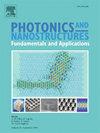Voltage-induced transparency of photonic crystal microcavity with chiral liquid crystal layer
IF 2.5
3区 物理与天体物理
Q3 MATERIALS SCIENCE, MULTIDISCIPLINARY
Photonics and Nanostructures-Fundamentals and Applications
Pub Date : 2025-02-01
DOI:10.1016/j.photonics.2024.101350
引用次数: 0
Abstract
A resonant microcavity with photonic crystal mirrors and a chiral liquid crystal resonant layer is fabricated. In our experimental set-up the microcavity is illuminated at Brewster’s angle, for which the TM-polarized scattering channels are open, while the TE-polarized channels are closed. Thus, the problem is reduced to two-channel scattering. By applying an external voltage to the resonant layer it is possible to control the position, linewidth and amplitude of multiple resonant lines via changing the radiation decay rate into the scattering channels due to polarization mixing within the chiral layer. It is found, that under a certain value of the applied voltage, the microcavity becomes transparent over a wide spectral range, i.e. none of the resonant modes can be excited.
具有手性液晶层的光子晶体微腔的电压诱导透明性
制备了具有光子晶体反射镜和手性液晶谐振层的谐振微腔。在我们的实验装置中,微腔以布鲁斯特角照射,其中tm偏振散射通道是打开的,而te偏振散射通道是关闭的。因此,问题被简化为双通道散射。通过对谐振层施加外部电压,可以通过改变手性层内极化混合引起的散射通道的辐射衰减率来控制多条谐振线的位置、线宽和幅度。研究发现,在一定的外加电压下,微腔在很宽的光谱范围内变得透明,即谐振模式都不能被激发。
本文章由计算机程序翻译,如有差异,请以英文原文为准。
求助全文
约1分钟内获得全文
求助全文
来源期刊
CiteScore
5.00
自引率
3.70%
发文量
77
审稿时长
62 days
期刊介绍:
This journal establishes a dedicated channel for physicists, material scientists, chemists, engineers and computer scientists who are interested in photonics and nanostructures, and especially in research related to photonic crystals, photonic band gaps and metamaterials. The Journal sheds light on the latest developments in this growing field of science that will see the emergence of faster telecommunications and ultimately computers that use light instead of electrons to connect components.

 求助内容:
求助内容: 应助结果提醒方式:
应助结果提醒方式:


